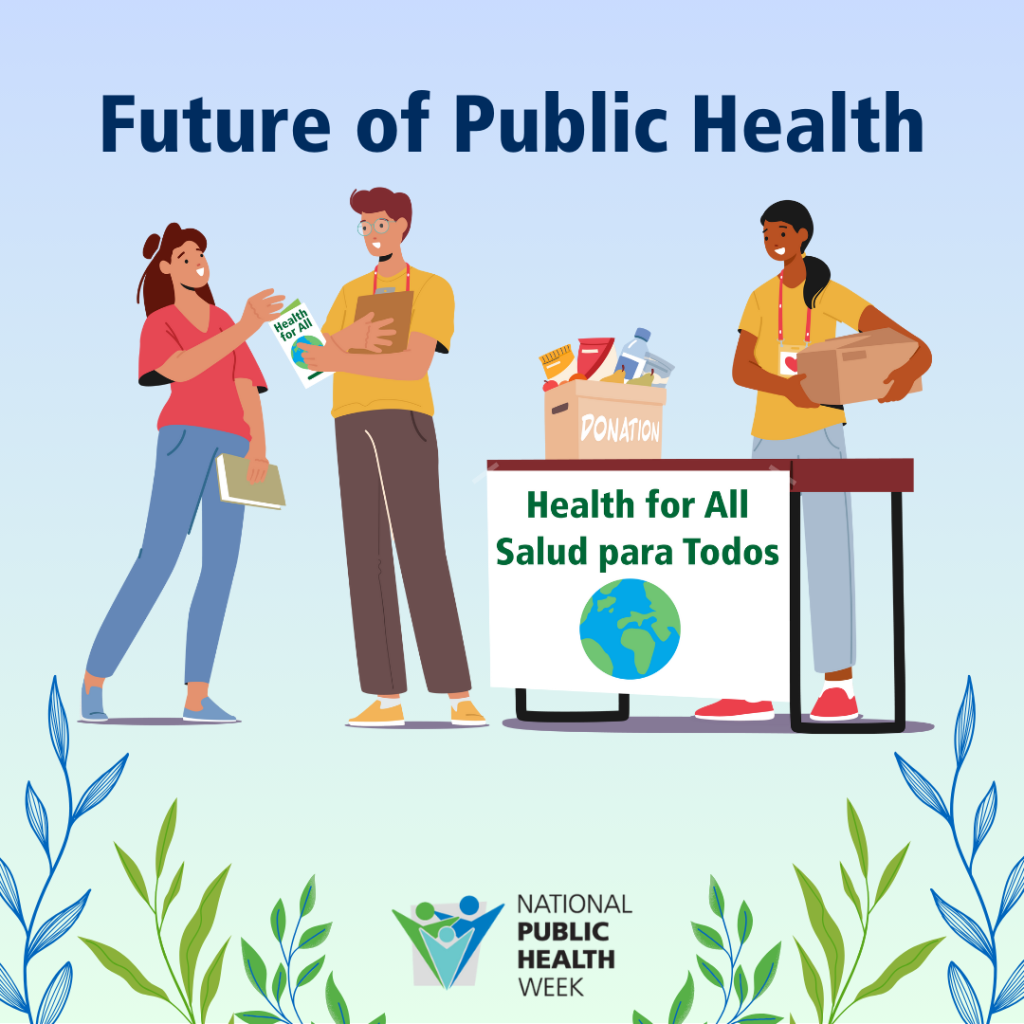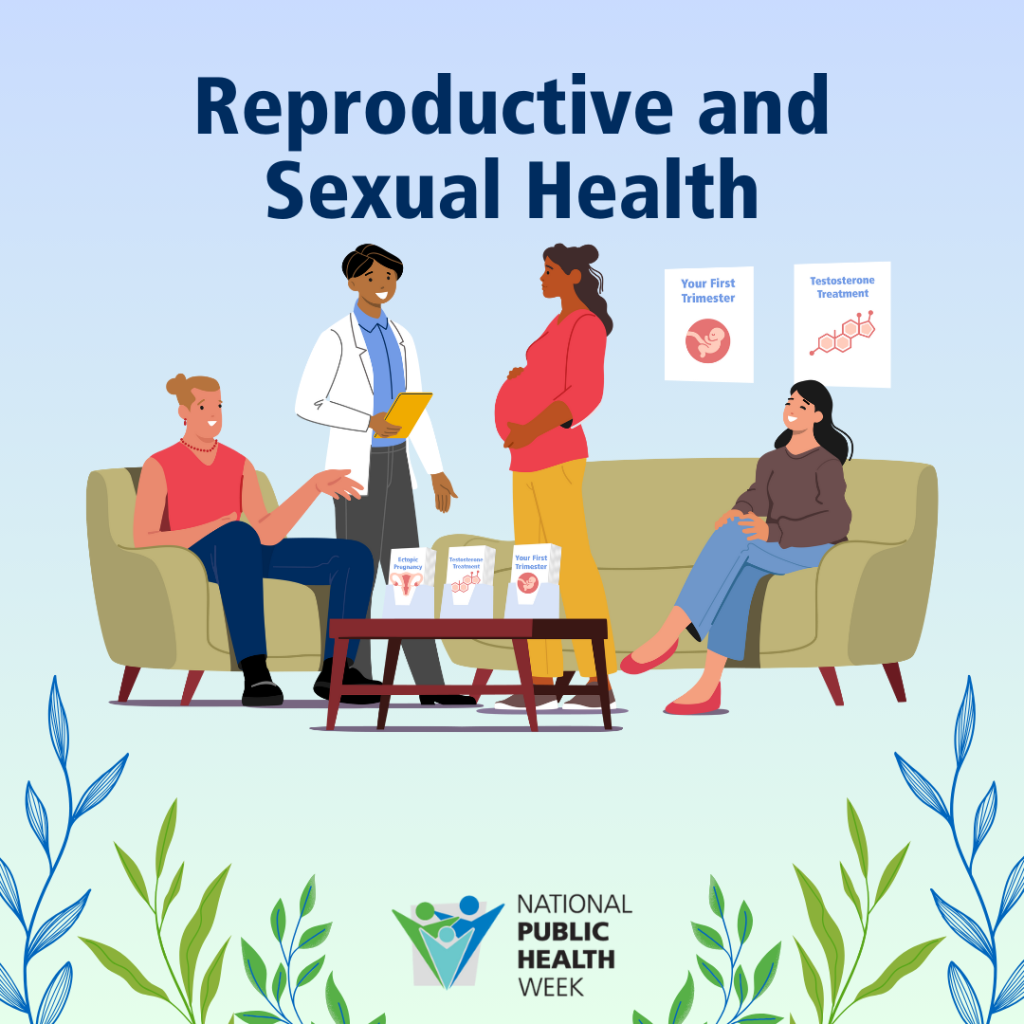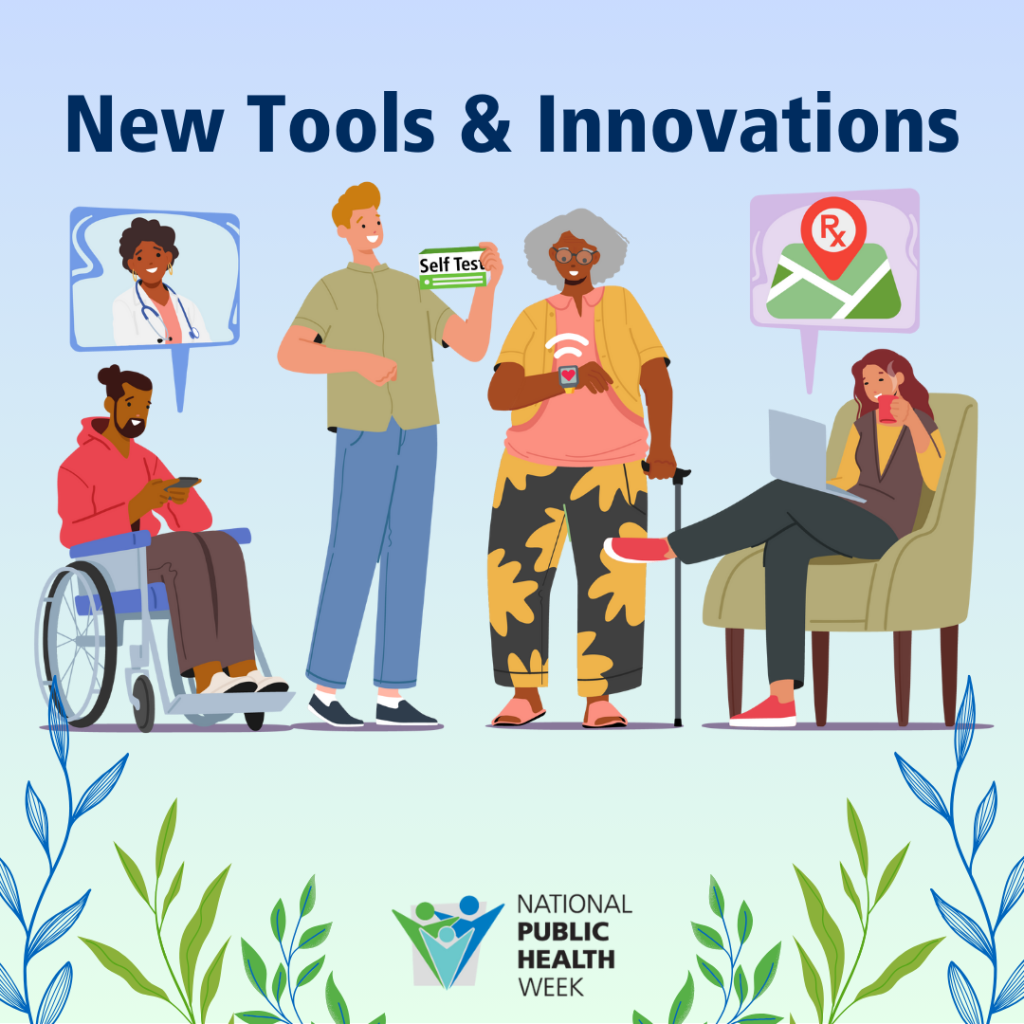Through our programs, with a focus on disease prevention and health promotion, we are helping to ensure your health and safety. Call 541-889-7279 to make an appointment or to learn more about our services. Stay up to date with public health news below.
National Infant Immunization Week

It’s National Infant Immunization Week! We want to use this opportunity to highlight the importance of protecting infants and young children from vaccine-preventable diseases. Learn more about the importance of keeping your children healthy with immunizations below and call our clinic at 541-889-7279 to schedule an appointment to stay up to date on all vaccines for your family.
- COVID-19 has caused many disruptions in families’ lives – and in some cases, it has meant that children have missed or delayed their wellness checkups and vaccination, which are a critical part of ensuring children stay healthy. CDC and the American Academy of Pediatrics (AAP) recommend that children stay on track with their well-child appointments and routine vaccinations.
- Most parents choose the safe, proven protection of vaccines. Giving babies the recommended vaccinations by age two is the best way to protect them from serious childhood diseases, like whooping cough (pertussis) and measles.
- Vaccines are among the most successful and cost-effective public health tools available for preventing disease and death. Vaccines help protect both individuals and communities by preventing and reducing the spread of infectious diseases.
- Vaccination is a shared responsibility. Families, healthcare professionals, and public health officials must work together to help protect the entire community.
- Vaccines are safe. The U.S. has a long-standing vaccine safety system that ensures vaccines are as safe as possible. As new information and science become available, vaccine recommendations are monitored, updated, and improved.
- Trust in vaccines is built through millions of conversations between parents, doctors, nurses, pharmacists, and community members. NIIW provides an opportunity to encourage vaccine conversations at all community levels.
Follow the CDC for more here: https://www.cdc.gov/vaccines/index.html
Caregivers Conference Saturday, April 27th
The Annual Investment in Caregivers Conference is coming up Saturday, April 27th at FRCC (676 SW 5th Ave, Ontario). Registration is available at Eventbrite. Contact Sarah Poe, MCHD Director and one of the conference keynote speakers, if you need a scholarship at sarah.poe@malheurco.org or 541-823-3227.
Please share the fliers:
- Caregiver Conference
- Workshop descriptions
- Speaker bios
- Agenda
- Pre-conference Spanish session with Detective Rachel Rieger from BeSure Consulting (for Spanish speaking parents and caregivers)
Join us for a day of learning and connection! This year’s theme is Safety & Belonging.
Featuring sessions for every caregiver, exhibitor booths and plenty of networking, the Caregiver Conference is for people who care for others. Workshop materials, a continental breakfast and lunch are all included with registration. Scholarships, Spanish interpretation of select workshops, CEUs, and PDUs are available.
Register Now!
Public Health Is: Preparing for the Future

Public health needs to take a fresh approach — one rooted in fairness and inclusivity. Picture this: a world where equity isn’t just a buzzword, but a guiding principle. Communities are at the heart of decision-making and actively shaping their health, not sidelined. Public health’s future is all about teaming up — joining forces with unexpected partners from different sectors and centering community voices. This future is about tearing down barriers, not just fixing problems but preventing them altogether. It’s making sure every person has access to the support and care they need for a healthier life.
You can make a difference in the future of public health!
Speak for health. Use your voice to advocate for policies that prioritize community well-being. Educate others about public health issues and get in touch with your lawmakers to enact change. APHA’s action alerts make it easy to send messages to your elected officials to tell them about the issues that matter to you.
Join community organizations. Getting involved with community organizations allows you to contribute to initiatives that promote health equity at the local level. For example, participating in a mutual aid network might involve sharing resources within the community during tough times, building a strong support system. This active participation helps create a healthier future where local communities have collective power, ensuring everyone’s well-being.
Communities/Neighborhoods
Make information accessible. Health information should be easy for everyone to understand. Community groups can share resources in multiple languages and avoid jargon so everyone can access and grasp important health information.
Support good public health policies. Communities can champion proactive public health policies by organizing advocacy campaigns, gathering community input and directly engaging with policymakers to ensure these policies address specific local needs and priorities.
City/State
Fund community organizations and health departments. Consistent, long-term funding for community organizations and health departments is vital. Establish reliable funding mechanisms and grants to ensure ongoing support for critical public health initiatives and services.
Declare racism as a public health crisis. Recognizing racism as a public health crisis is a necessary step. Acknowledging systemic issues and taking targeted action to dismantle health disparities rooted in racial injustice is crucial.
Nation
Invest in the public health infrastructure. Building a solid health infrastructure is like laying a strong foundation for a house. Strong systems and sustained, equitable funding support the health and well-being of everyone in the country.
Building cross-sectoral partnerships. To achieve the equitable, sustainable public health system we all want, we need broad participation. Public health, health care, grassroots organizers, faith-based communities, business, philanthropy, law, education and government — all of us have a stake in public health’s future. Let’s actively bring in non-traditional partners to join forces for a more inclusive and effective public health future.
International Leaders
Create global health partnerships. Countries working together can ensure a future of better health and well-being for all people everywhere. Partnerships connect knowledge, ideas and resources to bring the changes we want to see such as preventing infectious disease outbreaks and delivering vaccines and supplies.
Support efforts to prepare for global pandemics and emergencies. Training more people globally can help prevent, detect and tackle public health threats. By increasing and improving how we test, monitor and report on significant global health incidents, all countries can work cooperatively to save lives and bring improved health outcomes to everyone.
Learn more about National Public Health at https://www.nphw.org/.
Public Health Is: Emergency Preparedness

Unexpected events such as power outages and natural disasters like earthquakes and hurricanes can happen without a moment’s notice. That is why being ready for emergencies is crucial. Emergency preparedness is exactly what it sounds like; it involves planning, having supplies on hand and knowing how to stay safe during an emergency. Being ready for crises before they happen can not only protect you and your loved ones but also underserved communities where disasters can worsen inequities.
You can make a difference with emergency preparedness!
Build an emergency supply kit. Being prepared means stocking up on supplies. An emergency supply kit is a collection of tools that can help in the event of an emergency. Kit supplies can include flashlights, nonperishable food, extra clothes, a first aid kit and personal hygiene items. You also should have a gallon of water per person/pet per day, for three days, if possible.
Have a plan. Create an emergency plan with your family, friends or household. Designate a meeting spot where you all can gather in case you’re separated during an emergency. Learn your local emergency alerts and warnings. Practice emergency drills and memorize evacuation routes.
Communities/Neighborhoods
Host a disaster training. Disaster trainings can teach communities how to prepare and handle emergencies. Volunteer with local and national organizations, like the American Red Cross, to provide training to community members on how to act before, during and after a disaster. Assist organizations, such as food pantries and daycares, in building capacity and emergency planning by sharing tools like virtual disaster preparedness training.
Mark emergency exits and practice emergency drills. If there’s a fire, flood or other disaster, people need to know where to go. All public buildings are required to have clearly marked emergency exits. Evacuation route signs can also warn people of dangers to avoid during emergencies. Encourage schools and local businesses to conduct drills, such as fire or lockdown drills, to ensure that everyone in the community knows where to go during an emergency, even when they aren’t home.
City/State
Educate students on emergency preparedness. Disasters can be stressful for people of all ages, including children and teenagers. Schools can help prepare students for emergencies through educational opportunities like assemblies, class projects and preparedness drills. Trainings can be tailored so they are age-appropriate, useful and not scary. Making sure students are equipped for unexpected events can protect their mental health and help them recover quickly from emergencies.
Regularly test emergency alerts. There are emergency alert systems in most communities. Sirens are still used in many places, but there are also digital options now like mobile alerts, TV and radio. City and state officials should regularly test alert systems to ensure that future warnings will go through in a real emergency. They should remind residents what alerts look or sound like and what to do when an alert sounds. Most importantly, they should consider using alert systems that provide multilingual alerts and appropriate messaging for those with disabilities.
Nation
Fund mitigation efforts. Mitigation is about taking action before disaster strikes to lessen its impact. Allocating funds toward mitigation will promote more projects made to protect the environment such as green infrastructure. The federal government should provide funding to local organizations to work on community projects to better prepare their areas. This can help reduce the financial burden on communities and make response and recovery time for disasters more efficient.
Improve equity in disaster recovery. Due to our nation’s long history of systemic and environmental racism, people from racial and ethnic minority groups are the ones most affected by disasters. Federal agencies must continue providing funding for emergency initiatives, especially in communities that are disproportionately impacted by disasters. The federal government must address equity before disasters happen by building resilience and investing in disadvantaged communities.
Learn more about National Public Health at https://www.nphw.org/.
Protect Your Adolescent
Today marks the end of Adolescent Immunization Action Week (AIAW), a yearly observance aimed at raising awareness around the importance of adolescent immunizations that help protect teens against diseases and infections. At Malheur County Health Department, we encourages parents and caregivers to talk with their children’s health care provider about getting adolescents up to date on their vaccinations.
Measles cases are on the rise in the United States this year. According to the Centers for Disease Control and Prevention (CDC), as of March 28, a total of 97 measles cases were reported in 17 states across the country, including Washington and California. There haven’t been any measles cases in Oregon yet this year, so it’s a timely opportunity for children to receive measles vaccination and ensure the entire family is protected.
In addition to measles vaccination, CDC recommendations include:
- A tetanus/diphtheria/pertussis (Tdap) booster at ages 11-12. (In Oregon, a Tdap booster is required before starting 7th grade.)
- Human Papillomavirus (HPV) vaccination at ages 9-12 to help protect from HPV-related cancers in adulthood.
- Meningococcal vaccination at age 11, and again at age 16.
To learn more about these and other recommended and required adolescent immunizations in Oregon, visit the OHA Adolescent Immunization website or call and schedule an appointment with our clinic at 541-889-7279.
Save the Date: Eastern Oregon Health Equity Conference
Mark your calendar for September 26, 2024 for the Eastern Oregon Health Equity Conference! Join us to connect and collaborate to advance community health and equity during a robust day focused on solutions and strengths. Hosted by Four Rivers Healthy Community, in partnership with many community organizations.
Keynote Dr. Sejal Hathi
We are thrilled to announce that Oregon Health Authority Director, Dr. Sejal Hathi, will be the keynote speaker for the Eastern Oregon Health Equity Conference! With a very busy schedule, we are fortunate Dr. Hathi is making time to support our efforts.
Download and share the Save the Date flyers in English and Spanish.
Join the Health Equity Conference Planning Committee
We need more people to join the planning committee, meeting virtually the fourth Tuesday of each month from 1-3 p.m. Mountain Time. The link is below. Please join us! You can also copy the calendar invite from our Events Calendar.
Google Meet joining info: Video call link: https://meet.google.com/puf-kzdq-wep
Prevention Event 4/24: Operation Fentanyl
Join the Lifeways Prevention team for a free event aimed to educate the community about fentanyl.
Informed Minds: Operation Fentanyl will take place April 24th at 6-8 p.m. in the Ontario Middle School gymnasium (573 SW 2nd Ave, Ontario).
Topics will include:
- What is fentanyl?
- How is it affecting our community?
- What can you do to stay safe?
- Facts, resources, and data
This event will provide free Spanish translation, childcare, and a meal voucher for each family.
Register today!
This event is hosted by Lifeways, one of our community partners in our effort to prevent overdose and save lives. For more information about fentanyl from our Peer Recovery Mentors and to get free overdose reversal medications and harm reduction supplies including fentanyl test strips, visit the Malheur County Health Department at 1108 SW 4th Street in Ontario or call us at 541-889-7279.
Public Health Is: Reproductive and Sexual Health

When people have access to quality reproductive and sexual health care and education, they can live happier and healthier lives.
You can make a difference and destigmatize reproductive and sexual health!
Get screened for cancers and tested for STIs. Breast, colorectal and prostate cancers are three of the most common forms of cancer in the United States. Reported cases of sexually transmitted infections like chlamydia, gonorrhea and syphilis have continued to rise in the U.S. Protect yourself by getting tested for STIs yearly. Learn the risks for developing breast and colorectal cancer, such as smoking tobacco, drinking alcohol and being inactive. Take steps to prevent those risks. Get screened based on current guidelines to detect prostate cancer early. People with vaginas should also get regularly screened for human papillomavirus, a very common STI that can lead to certain cancers or genital warts. There is no routine test for HPV for people with penises.
Practice safe sex. Reduce your risk of spreading STIs like HPV and HIV by getting tested yearly; using barriers, such as condoms, for all forms of sexual intercourse; and practicing open communication with your sexual partners. Get consent for sexual activity, and stop immediately if either of you is uncomfortable, feels unsafe or is in pain. Visit your local health center to get condoms, lubricant and other disease-preventing tools.
Communities/Neighborhoods
Donate menstruation products to local shelters. Before the COVID-19 pandemic, an estimated 500 million individuals who menstruate experienced period poverty. Period poverty is a lack of access to menstrual products, education and sanitation facilities. Homeless shelters, health centers and even schools can provide the community with menstrual products. You can help by donating new, unopened packages of pads, tampons and other menstruation products to a local homeless shelter. Take it a step further by calling the shelter and asking if there is a need for items like heating pads, pain relief medication or perhaps some chocolate!
Promote comprehensive sex education in local school districts. Comprehensive sex education is age-appropriate, medically accurate and empowers students to make informed decisions about their overall health. Studies present that comprehensive sex education can lead to a decrease in STI rates, reduce sexual violence and increase youth use of contraceptive methods. States can require their public schools to teach sex education. Only 30 states/territories are mandated to teach sex education in K-12 and only five states require comprehensive sex education in K-12 schools. But school districts can decide on the curriculum. Attend school board and city hall meetings as an advocate and encourage your friends and family to support the adoption of comprehensive, age-appropriate sex education programs.
City/State
Expand access to reproductive health services. City and state governments can take a proactive stance by expanding access to reproductive health services. This includes supporting and funding clinics that provide comprehensive reproductive and sexual health care, including family planning services and STI testing and counseling. By prioritizing accessible and affordable reproductive health services, cities and states can contribute to the overall well-being of their communities.
Nation
Pass legislation protecting reproductive and sexual health care access for all. Members of Congress are responsible for writing and passing federal laws, meaning they can pass legislation protecting access to family planning services and LGBTQ+ services. Contact your representatives to let them know what matters to their constituents – you!
Combat discrimination in reproductive health care. Congress can create laws explicitly preventing discrimination based on factors like race, gender identity, sexual orientation and socioeconomic status. This includes supporting training initiatives for health care providers to deliver culturally competent and inclusive care, creating respectful and understanding health care environments. Congress can also advocate for the use of demographic data to identify and address disparities in reproductive health outcomes. By working with advocacy groups and health care professionals, Congress can ensure its efforts are responsive to evolving needs, fostering a more balanced and inclusive reproductive healthcare system for everyone.
Learn more about National Public Health at https://www.nphw.org/.
Public Health Is: New Tools and Innovations

Public health is all about preventing disease, diagnosing health conditions and encouraging health and well-being. However, achieving these goals wouldn’t be possible without the help of new tools and innovations in public health. From wearable fitness bands to virtual doctors’ appointments, new technology has changed the way individuals and communities receive and respond to health information. Other tools, like warning systems for natural disasters or COVID-19 testing kits, can help individuals stay connected and protected during emergencies. Advancements in public health can help us in the fight towards equity, so all people and populations can thrive.
You can make a difference with new tools and innovations!
Wear smartwatches and use health apps. Adults need 150 minutes a week of moderate-intensity activity. Physical activity can help improve mental health, reduce the risk of illnesses such as heart disease and Type 2 diabetes and manage chronic health conditions like arthritis. Use wearable health devices, such as smartwatches, or health apps that track physical activity to monitor how much activity you are getting every day. You can even use these tools to engage in some friendly competition with friends and family through NPHW’s Keep it Moving Challenge.
Advocate for public health using media. While not a new tool, digital media plays a strong role in health advocacy and public health awareness campaigns. Use social media to share the real-life impacts of public health by telling your story. Sign on and share APHA’s Action Alerts to elevate your voice on public health issues like violence prevention and climate change.
Communities and Neighborhoods
Make vaccinations and testing more widely available. Testing and vaccine technology have expanded, making it easier to detect, prevent and protect us from more diseases. Vaccines protect us from serious illnesses, like whooping cough. Testing can help people diagnose their illnesses and receive treatment. Communities can open pop-up vaccination sites and make sure free at-home tests for illnesses like COVID-19 are available. Share accurate and easy-to-read vaccine resources.
Use vending machines to deliver lifesaving medications. Vending machines are an older technology that is being transformed to deliver lifesaving tools like Narcan and fentanyl strips. In 2021 alone, more than 106,000 people died from drug overdoses. Neighborhoods in Washington, D.C. are currently fighting to reduce drug-related deaths by increasing access to harm-reduction vending machines.
City/State
Increase access to telehealth services. Compared to urban populations, rural residents are more likely to die prematurely from conditions like heart disease and cancer. Telehealth, or receiving health care via video chat, phone call or messaging, is a great option for people who live in rural or remote areas. Telehealth helps overcome obstacles that prevent people from receiving care, such as limited access to health care providers and transportation. It also offers both flexibility and comfort with appointments which can be useful for those who have special health needs.
Broaden internet access. Internet access connects people to mental, behavioral and physical health services. It connects us to our local officials. It can also improve access to education and connect us to jobs and trainings where we live. However, 9 million people in the United States do not have access to high-speed internet, including communities of color, older adults and populations that live in rural or segregated urban areas.
Nation
Invest in public health surveillance. Being prepared for and ready to respond to emergencies is so important when faced with natural disasters. Surveillance tools like GIS mapping can help us in times of emergency by monitoring outbreaks, identifying where important health facilities are and tracking environmental hazards. Federal policymakers must continue investing in such tools to remain resilient and prepared for emergencies.
Improve digital health infrastructure. COVID-19 highlighted the importance of making health data digital. Electronic health information exchanges speed up how providers and patients can access medical information, while electronic health records enable providers to give efficiently deliver care to their patients. Federal and state leaders must support policies and fund data modernization to protect and improve the nation’s health.
Learn more about National Public Health at https://www.nphw.org/.
Caregiver Conference Registration is Open
Join us at the upcoming Caregiver Conference, Saturday, April 27th, at the Four Rivers Cultural Center. MCHD Director Sarah Poe will join Michelle Bass for keynote talks and Detective Rachel Rieger will present on cyber security. The health department will also have a booth with information around our services, especially for families. The theme this year is Safety and Belonging, which is closely linked to our goals in public health.
Register now and share the flyer!
Featuring sessions for every caregiver, exhibitor booths and plenty of networking, the Caregiver Conference is for people who care for others. Workshop materials, a continental breakfast and lunch are all included with registration. Scholarships, Spanish interpretation of select workshops, CEUs, and PDUs are available.







